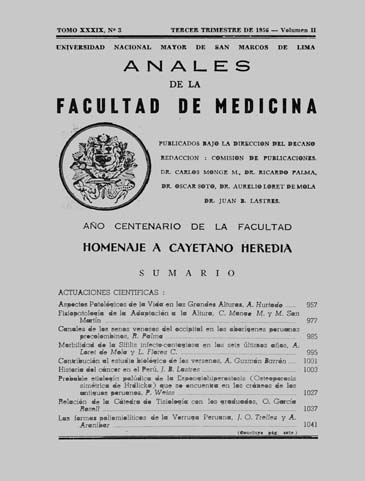Ventricular Septal Defect
DOI:
https://doi.org/10.15381/anales.v39i3.10841Abstract
For a while, following the original description of Roger, the ventricular septal defect was estimated as a benign lesion that does not alter the longevity of the carrier. However, there have been reports of infants and children with severe symptoms and disability states. Edwards, on the basis of anatomical and pathological collection of the Mayo Clinic, established that 19 of 30 patients with isolated ventricular septal defect had died before the age of 6 months. In the series of Maude Abbott, 1,000 autopsies of congenital heart disease, 21 of 50 cases of ventricular septal defects in membranous portion had died before 5 years of age.Downloads
Published
1956-09-28
Issue
Section
Trabajos originales
License
Copyright (c) 1956 Aurelio Peralta, Rafael Alzamora F., Marcos Roitman, José Bocanegra, Oswaldo Santibáñez, Jesús Bendezú, Dora Manrique

This work is licensed under a Creative Commons Attribution-NonCommercial-ShareAlike 4.0 International License.
Those authors who have publications with this magazine accept the following terms:
- Authors will retain their copyrights and guarantee the journal the right of first publication of their work, which will be simultaneously subject to Creative Commons Attribution License that allows third parties to share the work as long as its author and its first publication this magazine are indicated.
- Authors may adopt other non-exclusive licensing agreements for the distribution of the version of the published work (eg, deposit it in an institutional electronic file or publish it in a monographic volume) provided that the initial publication in this magazine is indicated.
- Authors are allowed and recommended to disseminate their work over the Internet (eg: in institutional telematic archives or on their website) before and during the submission process, which It can produce interesting exchanges and increase quotes from the published work. (See El efecto del acceso abierto ).
How to Cite
1.
Peralta A, Alzamora F. R, Roitman M, Bocanegra J, Santibáñez O, Bendezú J, et al. Ventricular Septal Defect. An Fac med [Internet]. 1956 Sep. 28 [cited 2025 Jun. 4];39(3):1205-21. Available from: https://revistasinvestigacion.unmsm.edu.pe/index.php/anales/article/view/10841



